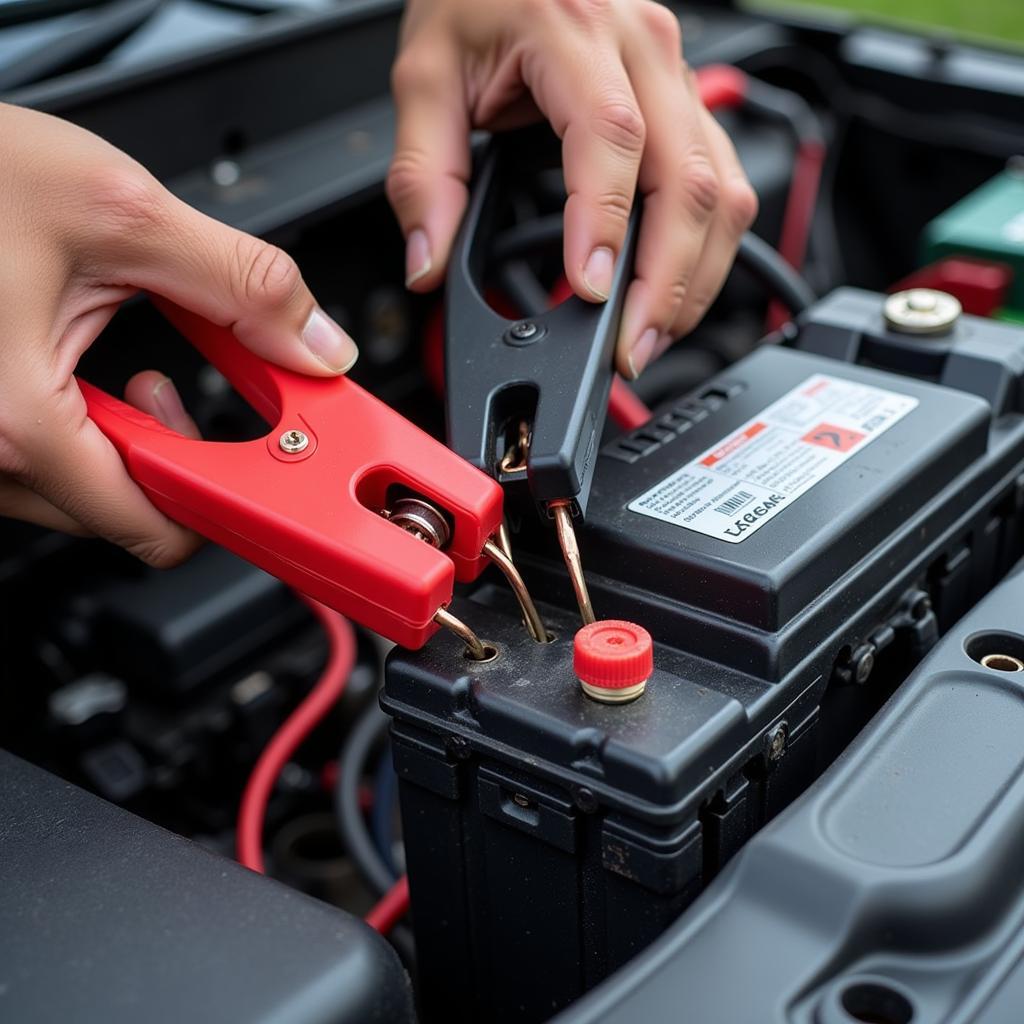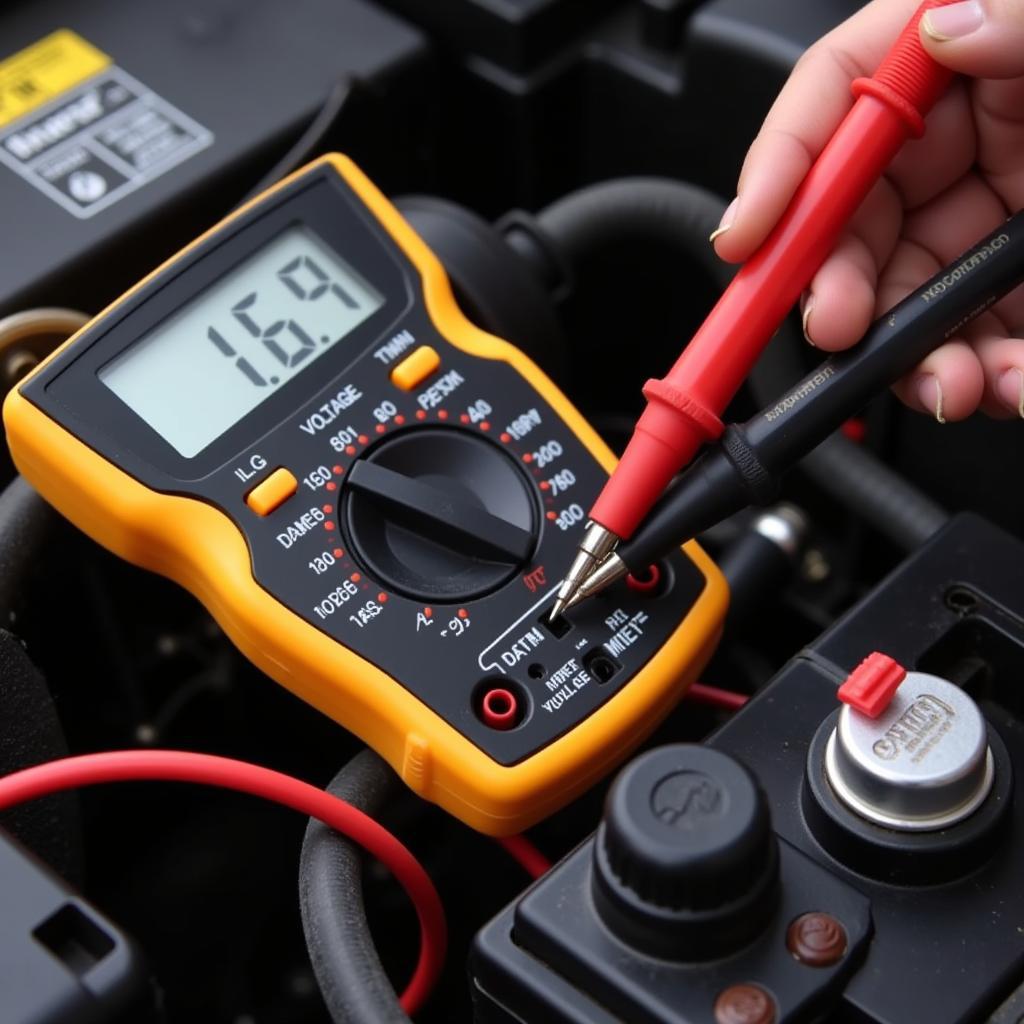A dead car battery is a frustrating experience, especially when you’re in a hurry. This article addresses the common problem of a “battery totally dead” situation, offering troubleshooting steps, solutions, and advice on how to prevent it from happening again. Read on to learn what to do when your car battery gives up the ghost.
 Car Battery Dead – Jumper Cables Connected to Another Car's Battery
Car Battery Dead – Jumper Cables Connected to Another Car's Battery
Why is My Battery Totally Dead?
A completely dead battery isn’t just an inconvenience; it’s a sign something’s wrong. Several factors can drain your car battery, from leaving your headlights on overnight to a faulty alternator. Sometimes, a dead battery is simply due to age. Like any component, car batteries have a limited lifespan. Over time, the chemical reactions inside the battery become less efficient, leading to a reduced ability to hold a charge. charging a totally dead battery is often the first step, but identifying the underlying cause is crucial.
Common Causes of a Dead Battery
- Parasitic Drain: Even when your car is off, certain systems like the clock, radio memory, and security system draw small amounts of power. A malfunctioning component or an aftermarket installation can sometimes cause excessive drain, leading to a dead battery.
- Extreme Temperatures: Both hot and cold weather can significantly impact battery performance. car battery dead in winter is a common scenario due to the increased power demands of cold-starting and the battery’s reduced capacity in freezing temperatures.
- Old Age: As batteries age, their internal components degrade, reducing their ability to hold a charge.
- Failing Alternator: The alternator recharges the battery while the engine is running. A faulty alternator won’t charge the battery properly, eventually leading to a complete discharge.
- Human Error: Leaving lights, interior lights, or accessories on can drain your battery overnight.
 Testing Car Battery with Multimeter
Testing Car Battery with Multimeter
What to Do When Your Car Battery is Totally Dead
So, you’ve walked up to your car, and it’s completely dead. car totally dead – what do you do now?
- Jump-Starting: The most common solution is to jump-start your car using jumper cables and another vehicle or a portable jump starter. Ensure you connect the cables correctly (red to positive, black to negative).
- Charging the Battery: If jump-starting works, you might still need to charge the battery fully. charger for dead car battery options range from trickle chargers to more powerful battery chargers.
- Testing the Battery: Once charged, test your battery with a multimeter to check its voltage. A fully charged battery should read around 12.6 volts.
- Checking the Alternator: A simple test to check if your alternator is working is to start your car and disconnect the positive battery cable. If the engine stalls, your alternator likely needs replacement.
“A dead battery is often the first symptom of a larger issue. Don’t just jump-start and forget about it. Take the time to diagnose the underlying cause to prevent future problems,” advises John Miller, a seasoned automotive electrical engineer.
Preventing a Dead Battery
Prevention is always better than cure. These simple steps can help you avoid a “battery totally dead” scenario:
- Regular Checks: Inspect your battery terminals for corrosion and clean them regularly with a baking soda and water solution.
- Turn Off Everything: Before leaving your car, double-check that all lights, accessories, and the ignition are off.
- Limit Short Trips: Short trips don’t give the alternator enough time to fully recharge the battery.
- Battery Maintenance: Have your battery tested regularly, especially in extreme weather conditions.
- Consider changing your key fob battery if you are having other electrical issues. Here’s a guide on how to change lexus key fob battery.
“Regular battery maintenance can significantly extend its lifespan and save you from the frustration of a dead battery,” adds Sarah Johnson, an automotive technician with over 15 years of experience.
Conclusion
A battery totally dead situation can be avoided with proper care and maintenance. By understanding the causes and following the steps outlined in this article, you can keep your car running smoothly and avoid the inconvenience of a dead battery.
FAQs
- How long does it take to jump-start a totally dead battery? Jump-starting usually takes a few minutes, but the car should run for at least 30 minutes afterward to recharge the battery.
- Can I jump-start a car with a totally dead battery from a smaller car? It’s generally not recommended, as it could strain the smaller car’s electrical system.
- How often should I replace my car battery? Car batteries typically last 3-5 years, but this can vary depending on usage and climate.
- What are the signs of a failing alternator? Dimming headlights, flickering interior lights, and strange noises from the engine bay can indicate a failing alternator.
- How can I test my car battery at home? A multimeter can be used to check the battery’s voltage.
- Is it safe to drive with a failing alternator? While you might be able to drive for a short distance, it’s not recommended, as the battery will eventually drain completely.
- Can a dead battery cause damage to my car? A prolonged dead battery can potentially damage sensitive electronic components in modern vehicles.
